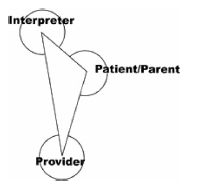APPENDIX 1
Positioning The Interpreter
The following should be done to effectively use an interpreter, particularly when someone other than a trained interpreter is used:
- Have a pre-interview discussion with the interpreter. (Tell the interpreter what you hope to accomplish with this interview and give a brief description of how the patient came to the current situation.)
- Position the interpreter to the side and slightly behind the patient/parent (see Figure).
- Look at the patient/parent and not at the interpreter. (Experienced interpreters actually avoid eye contact with everyone in order to promote optimal interaction between the clinician and the parent and/or patient.)
- Speak in short sentences and avoid jargon and phrases that may not translate well from English into another language, such as “the ball is your court.”
(It is important to note that interpretation refers to the spoken word, whereas translation is about the written word.)

Source: Horace M. DeLisser, MD, and Lisa Hark, PhD, RD, University of Pennsylvania School of Medicine, 2009. Used with permission